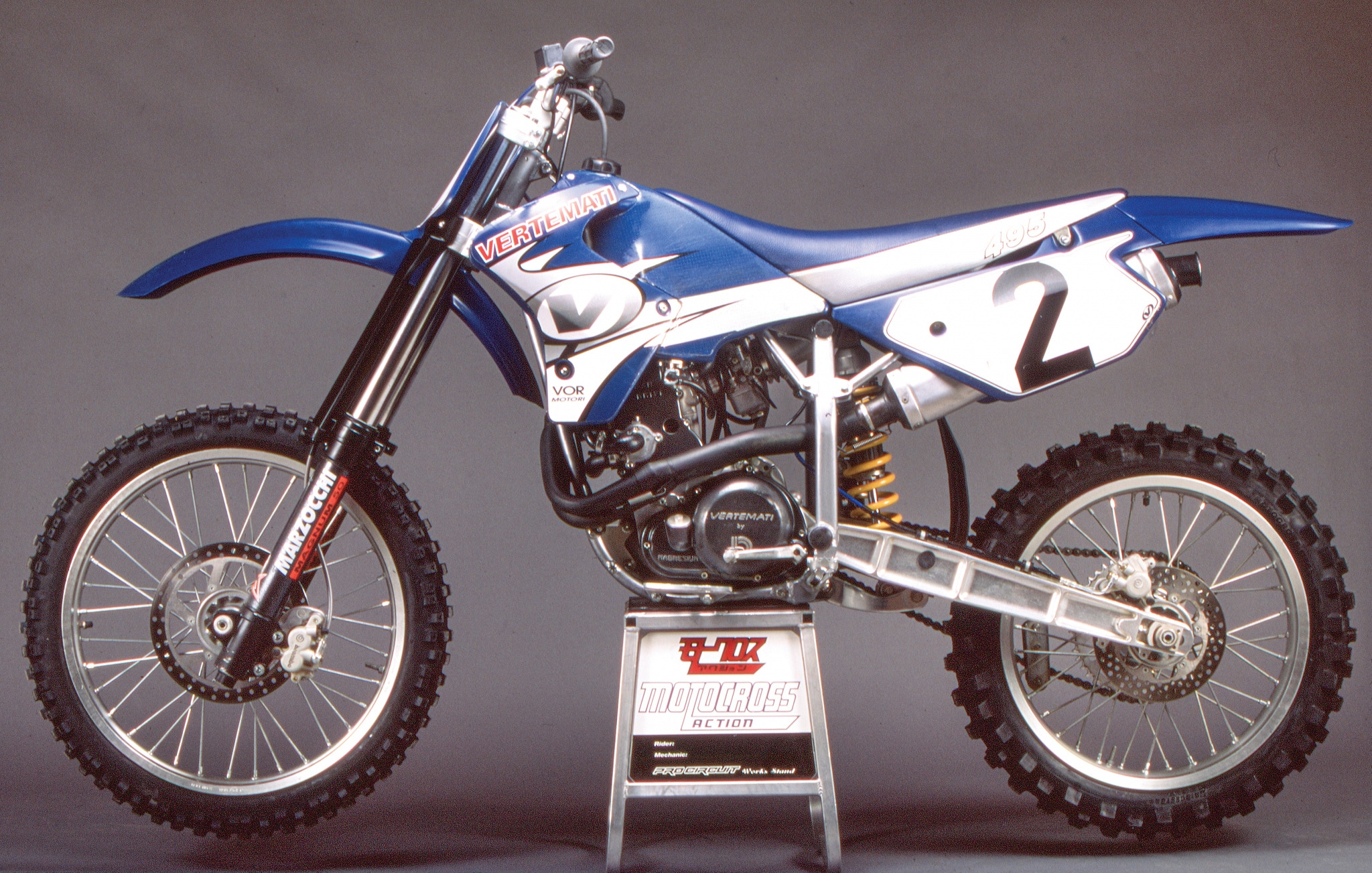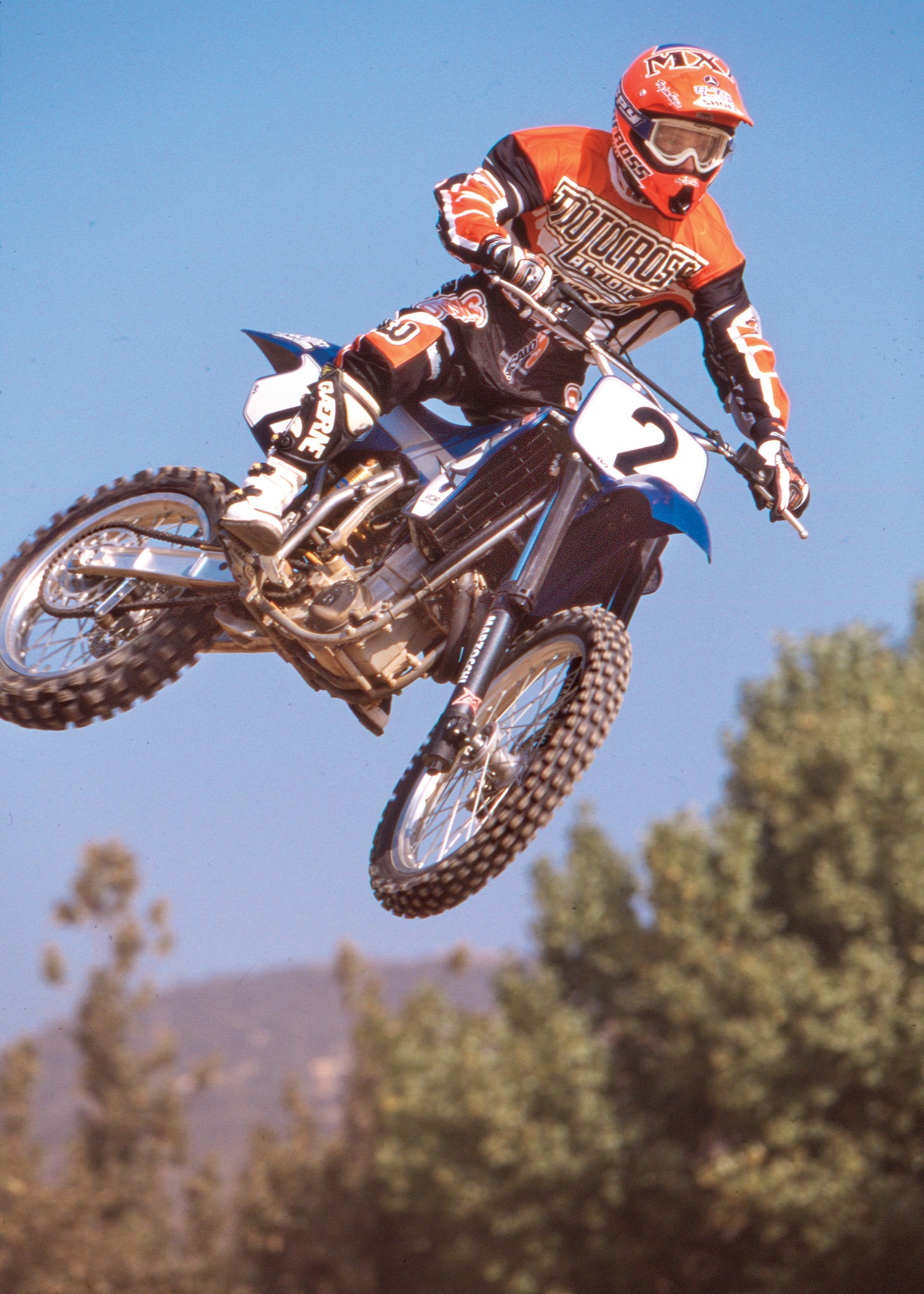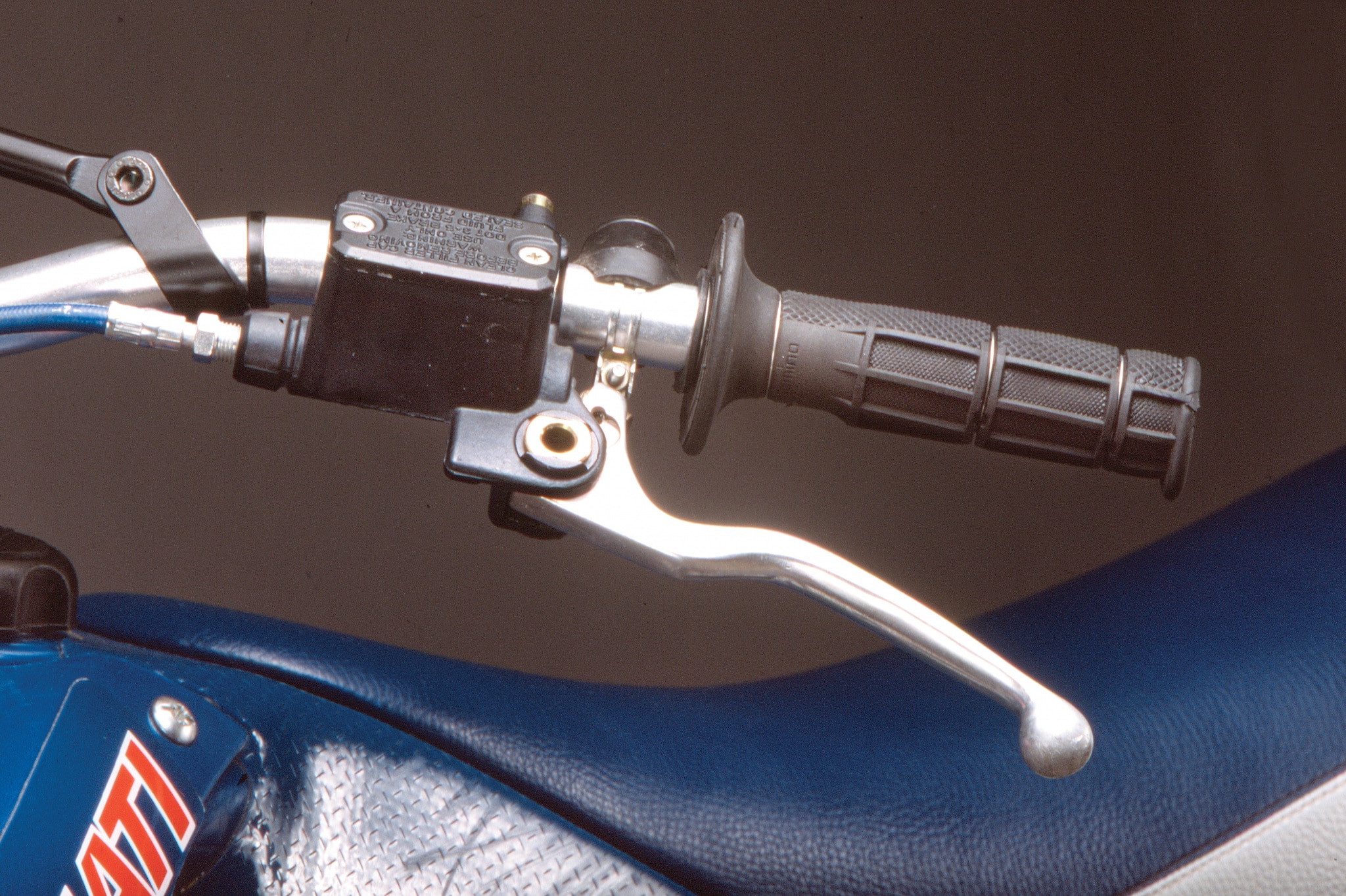MXA RETRO TEST: THE UNOBTAINABLE 1999 VERTEMATI V503
 The Vertemati V503 frame is more Erector Set than conventional motocross frame. The terrific engine is bolted into a frame that is also bolted together.
The Vertemati V503 frame is more Erector Set than conventional motocross frame. The terrific engine is bolted into a frame that is also bolted together.
We get misty-eyed sometimes thinking about past bikes we loved and those that should remain forgotten. We take you on a trip down memory lane with bike tests that got filed away and disregarded in the MXA archives. We love to reminisce on a piece of moto history that has been resurrected. Here is our test of the 1999 Vertemati V503 four-stroke.
THE 1999 VERTEMATI V503 FOUR-STROKE IS THE BRAINCHILD OF THE ECCENTRIC VERTEMATI BROTHERS. THERE ARE FEW BIKES AVAILABLE IN THE UNITED STATES THAT HAVE THE AURA OF COOLNESS THAT THE VERTEMATI POSSESSES.
There is something delicious about throwing a leg over a bike so rare that it’s the only one on the continent. While the 1999 Vertemati V503 is unique—it is, at the same time, faintly familiar. Futuristic and anachronistic in tandem, the V503 is a rare bird indeed. From beyond 10 feet, it looks like any other four-stroke (although mostly like a blue Husaberg), but when you step close enough to consider its singular elements, the Vertemati’s peccadilloes ambush you: (1) The frame bolts together (at the head tube, subframe, back bone and footpegs); (2) Drawing from the Handbook of Metallurgy, the frame components vary from machined, cast, and chromoly to series-7000 aluminum. (3)Equally peculiar are the backwards kickstarter, three-up tranny, I-beam swingarm and gear-driven cam.
 Starting life as a Husaberg, almost every part of the Vertemati engine was redesigned, but we don’t know which of the brothers wants to claim that he was in the charge of the 3-speed transmission—with neutral on the bottom.
Starting life as a Husaberg, almost every part of the Vertemati engine was redesigned, but we don’t know which of the brothers wants to claim that he was in the charge of the 3-speed transmission—with neutral on the bottom.
The Vertemati V503 is the brainchild of the eccentric Vertemati brothers. Guido and Alvero Vertemati were originally the Husqvarna importers for Italy, but when Cagiva purchased the Swedish brand (and moved it to Italy), the brothers switched their allegiance to another Swedish make, Husaberg. In the early days of the Vertemati/Husaberg alliance, the brothers fielded a high-end 500 Grand Prix race team that was a serious contender for the World Crown; however, as the V-brothers were gearing up to build a potpourri of special racing components, the Husaberg factory out-bid them for their star rider, Joel Smets. In the end, the Vertemati brothers decided to build their own bike. The result was a one-off program with most parts built in-house at the brother’s small shop in Truggio, Italy (although some castings and gears were farmed to outside suppliers).
TO CALL VERTEMATI A MOTORCYCLE MANUFACTURER PUSHES THE ENVELOPE BEYOND REASON. THERE HAVE BEEN SEASONS WHEN TOTAL PRODUCTION WAS LESS THAN 10 BIKES.
To call Vertemati a motorcycle manufacturer pushes the envelope beyond reason. There have been seasons when total production was less than 10 bikes. Even Vertemati’s sponsored Grand Prix riders were disgruntled by the slow march of production in Truggio. Recently, Bimoto, an Italian custom chassis builder, has taken over responsibility for Vertemati production and moved it to a new factory at VOR Motori in Monza. As a result, bike production is up, and there is hope that the rare four-strokes can be imported to the United States in the future (our bike was air freighted to the White Bros. Anaheim, California, R&D shop for evaluation as a potential import product).
Fire up the 503cc, single-overhead-cam, dual-exhaust port engine and you are rewarded with a pleasant four-stroke burble. The engine is, as you would expect from a former Husqvarna and Husaberg importer, a combination of Swedish design and Italian creativity. The 95mm by 71mm bore-and-stroke produces a rumbling, vibration-free staccato of old-world thumper vibes.
The engine is bolted into a double-cradle frame, but unlike anything you’ve ever seen before. The front cradle is bolted together at the footpegs and head tube (which is supported by an aluminum strut that braces the head tube in compression). Bolting a frame together is not new (Greeves did it in the 1960s), and there are technology mavens who believe that this construction technique allows stress to be absorbed during severe loadings, preventing other parts of the frame from exploding. In a questionable choice, Vertemati borrowed Husaberg’s in-the-backbone airbox idea (resulting in a very wide gas tank and small, still air space).
 Power comes in a steady crescendo over a long period of time. It signs off 1500 rpm before a Yamaha YZ400, but thanks to 103 extra cc, it isn’t lacking in the horsepower department.
Power comes in a steady crescendo over a long period of time. It signs off 1500 rpm before a Yamaha YZ400, but thanks to 103 extra cc, it isn’t lacking in the horsepower department.
Once kicked to life with the backwards kickstarter, last seen on Honda ATVs, the Vertemati is ready to go. It’s a big bike—tall, long and roomy. To get it into motion, you pull in the hydraulic clutch (a la KTM) and snick the shift lever upwards into first gear. That’s right—first gear is up, not down. The three-speed transmission works flawlessly. Shifting doesn’t have the notchy feel of most Euro bikes. Just the opposite. It shifts with very little tell-tale snick. Every MXA test rider was warned about the shift pattern—three-down with neutral on the bottom—but all came to grief on their first few laps.
Since the tranny shifts with buttery smoothness, racers couldn’t always feel each shift, and the necessity of keeping track of the number of shifts is incredibly important. In their best Clint Eastwood impressions, test riders had to ask themselves, “Did I shift two times or three? Am I in second gear or first? Do I feel lucky?” If you misjudged your downshifts, you could easily stick the bike in neutral on the entrance to a turn—and crash. After one crash each, no test rider ever went into neutral by mistake again (it was too painful). Still in all, neutral on the bottom is a liability.
On the other hand, the three-speed transmission works great. First gear is reserved for ultra-slow corners and riding to the starting line. Second gear handles all the acceleration chores. Third is for hyper thrust down long straights. Any more gears would be wasted energy.

Vertemati’s bolt-together frame doesn’t enhance the bike’s cornering ability. Vertemati needs to raise the swingarm pivot 3mm, increase low-speed compression damping and go to a straight-rate spring on the Ohlins shock.
Vertemati is not building a Yamaha YZ400 clone. First, it’s 103cc bigger than a YZ. Size matters in four-strokes. Bigger doesn’t always translate into faster, but it does give the designer more leeway in working with the powerband. Second, the Vertemati’s powerband is more traditional than that of the YZ400. Yamaha’s version of power is automobile-like. The V503 harks back to the feel of BSAs, CCMs and Triumphs. Third, torque plays a big role in making the Vertemati flow around a track. Thanks to ample flywheel, chugging low-end and well-timed power delivery—things happen in real time (nothing feels rushed).
Is it fast? Yes, if you ride it fast. Conversely, it can also be slow. It has that wind-in-the-face feel that can only come from an engine that responds to rider input without question. Is it faster than a YZ400? Yes. Quicker? No. Torquier? Yes. Higher revving? No. The YZ400 and V503 aren’t bookends; they don’t match. They aren’t built with the same person in mind. The Vertemati torques, chugs and tractors out of turns—the YZ400 goes purrrr.
 Thanks to plentiful torque, the three-speed transmission doesn’t require much clutch work; but, if it did, the proven Brembo hydraulic clutch doesn’t fade.
Thanks to plentiful torque, the three-speed transmission doesn’t require much clutch work; but, if it did, the proven Brembo hydraulic clutch doesn’t fade.
How does it handle? It’s Italian. What does that mean? From a geometry standpoint, it means a long wheelbase, rearward weight bias, slack head angle and tall center of gravity. What does all that tech-talk mean? It’s stable at speed but not the nimblest of motocross bikes. Any bike made (outside of Italy) will turn circles around it.
Contributing to the casual nature of Italian cornering is a tendency for the rear end to squat under acceleration. In tight berms and ruts, the squat is not a problem. It can be compensated for by moving forward and depending on hard braking to lighten the rear end; however, on fast sweepers the Vertemati’s acceleration-borne squat causes the front end to get light and caster like a wobbly shopping-cart wheel.
The positive aspects of the Vertemati’s handling package are superb straight-line stability, perfect tracking in loose sand and lots of dive and squat to work with in tight corners. The negative aspects are fast sweeping corners (unless you have dirt track experience), quick directional changes and flat corners. It hunts and pecks, pushes the front end, and prefers to be nudged rather than shoved into bends.
All in all, it’s Italian. If you’ve ever ridden a Husaberg, Husqvarna or TM, you have a pretty good idea of how the Vertemati feels.
THERE IS NO PRICE TAG ON AMERICAN-IMPORT VERTEMATIS, BECAUSE, AT THE MOMENT, NONE ARE BOUND FOR OUR SHORES. AS FOR PRICE, THE BEST ESTIMATE IS THAT THE BIKE WOULD HIT THE SHOWROOMS FOR UNDER TEN GRAND.

Without fuel, the Vertemati weighs 256 pounds—3 pounds heavier than a YZ400. Stopping power is very good thanks to Brembo brakes. Clutch action, while not as light as most limp-wristed 125 pilots might like, is consistent throughout a moto. Starting is a breeze, thanks to a well-jetted 38mm Dell’Orto and the unusual forward rotating kickstarter. Front suspension chores are handled adequately by 50mm Marzocchi Magnum forks. The rear is held up by an Ohlins shock. Both the conventional forks and Ohlins shocks are decent units, although the balance is not well thought out. The cast swingarm attracts a lot of attention with its machined look. The I-beam design is very trick looking. Fuel consumption was not aided by the less than 2-gallon gas tank (which is about as wide as the old YZ400 two-stroke tank).
 The V503 has a runaway-train chassis. It is supremely stable in a straight line but needs something to bank off of. The Sunset Limit could turn tighter.
The V503 has a runaway-train chassis. It is supremely stable in a straight line but needs something to bank off of. The Sunset Limit could turn tighter.
There is no price tag on American-import Vertematis, because, at the moment, none are bound for our shores. As for price, the best estimate is that the bike would hit the showrooms for under ten grand, but probably not until it is further fine-tuned to suit the American market. The White Brothers spent considerable time working on the suspension components to get them capable of absorbing American-style punishment, but more work would need to be done before putting any V503’s on a boat.
There are few bikes available in the United States that have the aura of coolness that the Vertemati possesses. But, when you break it down into performance categories, that cache comes largely from its unavailability.






Comments are closed.